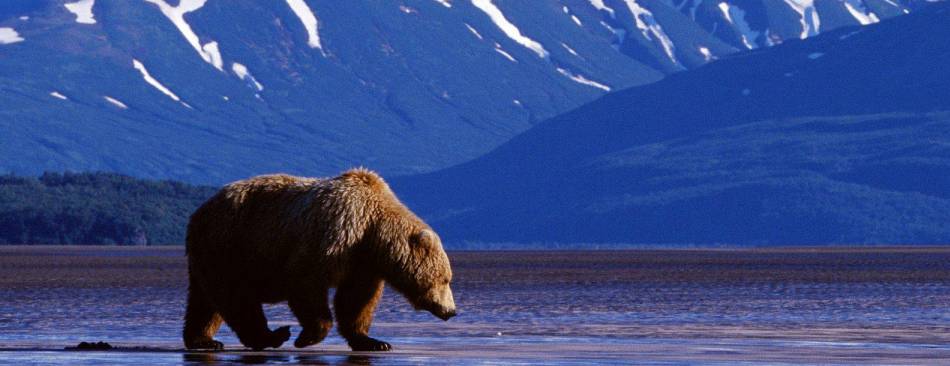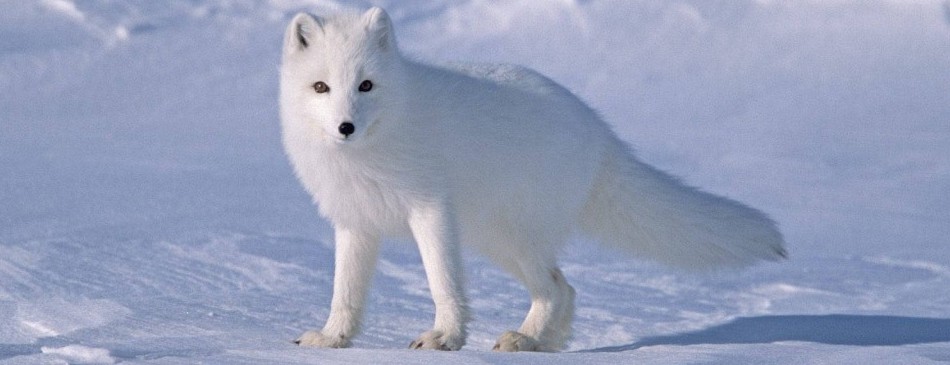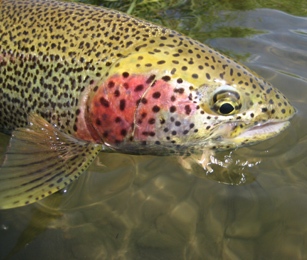Alaska has many lakes, rivers and streams with monster trophy trout lurking below the surface, yet, few fishermen have tapped into the great trout fishing Alaska has to offer or even seem aware of the fact that Alaska has a reputation for truly giant sized rainbow trout. The record rainbow trout caught in Alaska was 42 pounds, 3 ounces, caught in 1970 on Bell Island by David White.
Rainbow Trout
Rainbow trout share the similar, streamlined shape of salmon. However, their vibrant side colors of red and pink are a trademark that sets them apart from the ordinary. Coloration along the back is usually darker and ranges from blue-green to olive. The belly is white and the lower sides darken into silver. Like many other trout species, rainbows also are speckled with small black spots that appear on the lateral line, upper fins and tail. In some populations, adults also have spots on their lower sides. The color and overall body shape of rainbows are determined mainly by age, sex, and habitat. Rainbows are native to Kodiak Island, to Southeast Alaska and to Southcentral: the Kenai Peninsula, waters north of Cook Inlet and the Copper River drainage. The stocking of hatchery trout has extended the rainbow's range to near Fairbanks. Many small lakes are stocked in Southcentral. During spawning season, body color tends to darken. Natural populations of rainbows occur throughout the Alaska Peninsula, Kenai Peninsula, Kodiak Island and the Copper River and Kuskokwim River drainages. They can also be found in the river systems of the Naknek, Kvichak, Illiamna, Nushagak, Alagnak, Susitna and Togiak. The trout have been stocked in some Southcentral areas and as far north as Fairbanks. The largest rainbows belong to native populations. The clear streams and lakes of the Bristol Bay area produce trout up to 42 pounds.
Steelhead Trout
Steelhead trout are rainbows that spend part of their lives in the ocean. Steelheads are more streamlined and have a more silvery sheen than freshwater-only rainbows. Steelheads are found from the southern end of the Inside Passage to Southcentral Alaska and on to Cold Bay on the Alaska Peninsula. Adult steelheads like fast, deep, running water. Fish the deep holes in the stream, as well as white-water areas and behind rocks and log jams.
Cutthroat Trout
Cutthroat trout are aggressive, as one might guess from their name and red slash mark under the jaw. Cutthroats range from lower Southeast Alaska to Prince William Sound in Southcentral. Landlocked cutthroats may reach 24 inches, and sea-run fish reach 18 inches. Adults have a vivid red slash mark under the jaw. Cutthroat trout are aggressive feeders and will hit almost any lure, spinner or fly. Sea-run cutthroat can be taken in fresh water in the spring or during the fall when they enter fresh water to overwinter. They stay close to the bottom of deep pools or sloughs, and gear must be fished close to the bottom to ensure a hit.
Brook Trout
Brook trout are also called brook char. Brook trout are distinguished from most trout and salmon by a lack of any black spots on their body. In Alaska, brook trout have a dark green, worm-like marbling on their back and dorsal fin and bluish halos around some of the reddish spots on their sides. Otherwise, they resemble Dolly Varden, which lack the marbling and blue halos. They are found in Southeast Alaska. The brook trout was stocked in Southeast Alaska rivers, streams and lakes between 1917 and 1950. The fish seem to have done best in the barren subalpine lakes with relatively low food supply, marginal spawning, and year-round low water temperatures.
Lake Trout
Lake trout are found in almost every freshwater lake except for the Yukon-Kuskokwim lowlands and Southeast Alaska. They can be caught in abundance as far north as the Brooks Range and as far south as the Kenai Peninsula. Mountainous lakes with clear, cold water offer the most favorable habitat and rear the largest fish. Trout can also be found in glacial many glacial lakes. Adult lake trout primarily eat other fish, such as whitefish, grayling, salmon chub, sticklebacks, sculpins and various minnows. However, they also consume zooplankton, insect larvae, small crustaceans, clams, snails and leeches. When possible, they will devour small vermin and birds, but such occurrences are rare.
|







